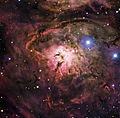Fail:Lagoon Nebula.jpg

Selle eelvaate suurus: 610 × 599 pikslit. Teised eraldusvõimed: 244 × 240 pikslit | 489 × 480 pikslit | 782 × 768 pikslit | 1043 × 1024 pikslit | 1841 × 1808 pikslit.
Algfail (1841 × 1808 pikslit, faili suurus: 2,92 MB, MIME tüüp: image/jpeg)
Faili ajalugu
Klõpsa kuupäeva ja kellaaega, et näha sel ajahetkel kasutusel olnud failiversiooni.
| Kuupäev/kellaaeg | Pisipilt | Mõõtmed | Kasutaja | Kommentaar | |
|---|---|---|---|---|---|
| viimane | 4. märts 2014, kell 03:20 |  | 1841 × 1808 (2,92 MB) | Lmbuga | Putting the nebula in the center of the image |
| 9. august 2012, kell 10:48 |  | 2027 × 2064 (1,59 MB) | Fabian RRRR | higher resolution | |
| 22. aprill 2010, kell 10:32 |  | 1280 × 1303 (317 KB) | EricHS211 | {{Information |Description={{en|1=Infrared view of the Cat’s Paw Nebula (NGC 6334) taken by VISTA. NGC 6334 is a vast region of star formation about 5500 light-years from Earth in the constellation of Scorpius. The whole gas cloud is about 50 light-year |
Faili kasutus
Seda faili kasutab järgmine lehekülg:
Globaalne failikasutus
Järgmised muud vikid kasutavad seda faili:
- Faili kasutus vikis ady.wikipedia.org
- Faili kasutus vikis alt.wikipedia.org
- Faili kasutus vikis av.wikipedia.org
- Faili kasutus vikis bn.wikipedia.org
- Faili kasutus vikis cs.wikipedia.org
- Faili kasutus vikis cv.wikipedia.org
- Faili kasutus vikis de.wikipedia.org
- Faili kasutus vikis en.wikipedia.org
- Faili kasutus vikis fr.wikipedia.org
- Faili kasutus vikis hu.wikipedia.org
- Faili kasutus vikis kaa.wikipedia.org
- Faili kasutus vikis kk.wikipedia.org
- Faili kasutus vikis koi.wikipedia.org
- Faili kasutus vikis ko.wikipedia.org
- Faili kasutus vikis kv.wikipedia.org
- Faili kasutus vikis lez.wikipedia.org
- Faili kasutus vikis mdf.wikipedia.org
- Faili kasutus vikis mg.wikipedia.org
- Faili kasutus vikis mk.wikipedia.org
- Faili kasutus vikis mrj.wikipedia.org
- Faili kasutus vikis olo.wikipedia.org
- Faili kasutus vikis os.wikipedia.org
- Faili kasutus vikis pl.wikipedia.org
- Faili kasutus vikis pt.wikipedia.org
- Faili kasutus vikis ru.wikipedia.org
- Faili kasutus vikis sah.wikipedia.org
- Faili kasutus vikis sh.wikipedia.org
- Faili kasutus vikis sk.wikipedia.org
- Faili kasutus vikis sv.wikipedia.org
Vaata selle faili globaalset kasutust.


